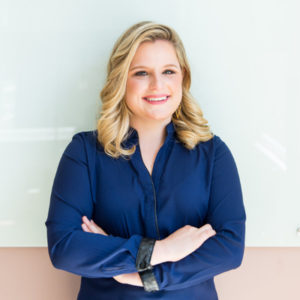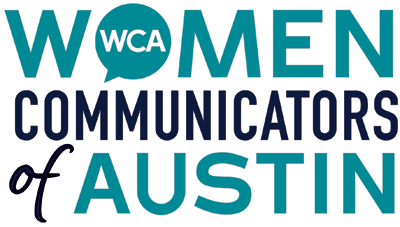 Emma Siemasko started off Freelance Austin’s September meeting with a discussion about …wait for it, toilets. She explained that her friend raved about her recent purchase of a bidet, touting its life-changing qualities, to the point where Emma went and purchased one for herself. Emma, founder of Stories by Us, said, “You may be asking yourself what a bidet has to do with case studies,” but she explained that she was moved to act because of a real-life success story, underscoring the power of case studies.
Emma Siemasko started off Freelance Austin’s September meeting with a discussion about …wait for it, toilets. She explained that her friend raved about her recent purchase of a bidet, touting its life-changing qualities, to the point where Emma went and purchased one for herself. Emma, founder of Stories by Us, said, “You may be asking yourself what a bidet has to do with case studies,” but she explained that she was moved to act because of a real-life success story, underscoring the power of case studies.
What is a case study, and why do I need one?
A case study is a story that shows the transformation that can happen when someone uses your product or service. If you’re a solo entrepreneur like me, you may wonder if you really need case studies to get new business.
In Emma’s experience, a case study can make the difference between getting the business and not getting it, and it can enlighten clients about capabilities they don’t know you have. “A case study gives you the opportunity to show what a portfolio cannot,” Emma explained.
Clients that need extra assurance or are budget-conscious, for example, are also likely to appreciate hearing examples of how you helped a client become successful. “The use of statistics can be very powerful,” Emma explained, “and the more expensive or risky the purchase, the more a case study is needed.”
And don’t just take it from Emma. According to the Content Marketing Institute, case studies work. Tech marketers, for example, “like their case studies. Most respondents (82%) said they use them. That’s well above the 69% we see among B2B marketers as a whole. Tech marketers say case studies are the highest-performing type of content they use for converting leads.”
Bottom line: Case studies can be powerful sales tools to get potential clients to hire you.
What elements make a great case study?
Emma recommends following this narrative:
- Summary
- Challenge
- Solution
- Results
“When you use the storytelling arc” – a story with beginning, middle and end – “you show the transformation that is going to make your case study stand out,” Emma said.
Emma explained that you are also “giving buyers a mirror” to envision themselves in the story and desire similar results.
Results are often in the form of statistics because they are easy to share, but results can also be qualitative; for example: “easier process, joy to work with, happier employees,” Emma said, all make a positive impact but are not attached to numbers.
Bottom line: Regardless of how you structure a case study, make it easy to read so that people can skim and get takeaways quickly.
How do you create a case study?
First, Emma recommends making a plan by considering questions such as: Why do I want to do this? Will I do it myself or hire someone to write and/or design it? Will I conduct the interview? Do I need to get a team on board?
Emma also shared these tips for conducting an effective client interview:
- Do it over the phone. There are nuances you can hear on the phone that you cannot get from written interviews.
- Set the context at the beginning. Remind clients of the process and purpose of the interview.
- Do not dominate the conversation – your job as the interviewer is to LISTEN.
- Ask for specific examples if clients provide vague accolades. If a client says, “Jennifer was great,” ask how she was great: what did she specifically do to earn your trust?
Bottom line: Make sure you are totally prepared and have your questions in advance.
“You get one shot at this – make it count,” Emma said.
What do I do with a case study once it’s completed?
Emma explained that you want to “bake case studies into your overall sales strategy.” For example:
- Use them in a pitch book or look book
- After you make the sale, use it as an on-boarding tool to educate clients about your services.
- Post them to the home page of your website.
- Include them in emails and proposals
Bottom line: Case studies are particularly helpful when a potential client needs a gentle push to close the deal.
Q&A Highlights
How did you get involved in specializing in case studies?
I did them for an employer, and I really liked them. I got to talk to people. I felt like I was creating more value for companies because of the immediate impact in showing how someone used their product and service.
If you already have the information about how you have helped a client, what is the advantage of asking clients to spend time with you to craft a case study?
It’s valuable to hear things during an interview that you may not know about. You can uncover things you weren’t aware of.
Do you ask clients to review the case studies after you draft it?
Yes, I always ask for approval and give them a chance to review before it is published. Our goal is to make the client look as good as possible, too. One recommendation: ask for their feedback outside of google docs – in other words, view only – to keep the back and forth down.
How do you ask clients to do a case study?
I ask them: “Are you interested in doing a case study – since we have been able to do xyz together, and it’s been amazing? Here is a sample case study to give you an idea of what it might look like.”
Ideal format of a case study?
800-1000 words
What if my client does not want use to use their name in the case study?
If you cannot include name of client, use a generic description. For example, if your client is Macy’s, you can say: “a major US retailer with 500+ stores.”
Do you use videos?
I shy away from it because it is a big ask for clients to go on camera – lighting, sound, etc. – and the cost is higher. Not to say you cannot do it, but it is more involved.
What about not wanting to nag a customer after they have agreed to it?
My rule is “three nags.” If I haven’t heard back, I ask them is there anything I can do to make it easier or I reach out again in 3-4 months.
How do you get the “biggest bang for the buck” with case studies?
If you do several, make sure they are geared to different types of clients that showcase different skills you have (copywriting, marketing strategy, etc.).
When is the best time to ask a client to do one?
Right after you finish because your client is “high” on the results. If you go back after a year, just be honest with them. For example: “I have been super busy, but I can’t stop thinking about this because we worked so well together.” A benefit to doing a case study later is that sometimes there are more results to share, and you can take that angle, too: “Have you had any more results since we worked together?”
Keep Up with Emma
Reach out to Emma for a complimentary list of case study questions she uses to prepare for interviews as well as sample case studies. Or stay in touch with her via LinkedIn; her website, or Twitter (@EmmaFayeS).
- Event Recap: Turn Adversity into Your Superpowers - February 27, 2022
- Event Recap: Everything You Need to Know about Pricing - January 25, 2022
- Event Recap: From Distraction to Intention - November 18, 2021
